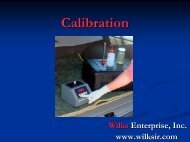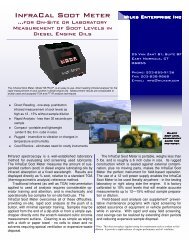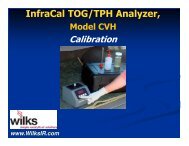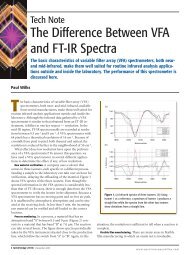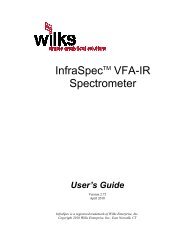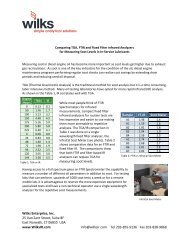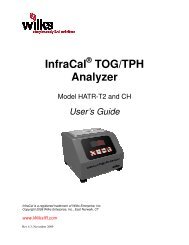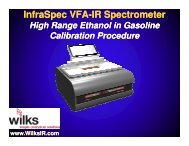Benefits of - Wilks Enterprise, Inc.
Benefits of - Wilks Enterprise, Inc.
Benefits of - Wilks Enterprise, Inc.
You also want an ePaper? Increase the reach of your titles
YUMPU automatically turns print PDFs into web optimized ePapers that Google loves.
The economic boost the US is getting from hydraulic fracturing is such a plus it would be a shame tohave environmental issues stifle it. Many industrial segments, as well as associated businesses, standto benefit from the inexpensive natural gas source.The ethane portion <strong>of</strong> the natural gas can be “cracked” to produce ethylene.Every industry that uses ethylene in their process will feel the positive effects.Ethylene is a building block with numerous uses including plastic bags, injectionmoulding, surfactants, detergents, textiles, food packaging, antifreeze,wire insulation, synthetic lubricants, tires and footwear.The recent move by the state <strong>of</strong> Vermont to ban hydraulic fracturing brings upthe environmental concerns coming from citizens. The fear is that groundwater,surface water, and drinking water risk contamination from drilling chemicals,gas leaks and radioactive elements released from the shale.InfraCal TOG/TPH AnalyzerHaving proper on-site environmental testing would help the industry’s public image as well as helpoperators at the well site. Oil in water testing is <strong>of</strong>ten one <strong>of</strong> the first measurements needed prior t<strong>of</strong>rac water treatment. On-site oil in water analysis can ensure that little or no contamination reachesfresh water sources as well as give operators information necessary in treating the wastewater forreuse or disposal.Wastewater from hydraulic fracturing comes from two sources — flowback water and producedwater. Water and chemicals are pumped down the well for the physical fracturing and what comesback to the surface is flowback water. It is a mix <strong>of</strong> the fracture fluid and water from the shale formation.Flowback water contains solids, metals, salts, chemical additives and trace amounts <strong>of</strong> oil. Oncethe well is producing, naturally occurring water comes to the surface as “produced water”. Producedwater has high levels <strong>of</strong> Total Dissolved Solids (TDS), minerals such as barium, calcium, iron andmagnesium that are leached out <strong>of</strong> the shale along with dissolved hydrocarbons 1 .In the first few days after fracturing, flowback water coming back out <strong>of</strong> the well can be greater than100,000 gallons a day. Once production begins, the produced water averages about 50 gallons perday. 2 While the produced water may appear to be a small amount, when that is multiplied by thenumber <strong>of</strong> wells then flowback water is added in, the total volume can be substantial. Pennsylvaniapredicted that as much as 19 million gallons per day <strong>of</strong> wastewater could be generated by gas wellsin 2011. 3Water management options include evaporation ponds, removal to an <strong>of</strong>f-site treatment facility, injectioninto disposal wells, and treatment for reuse in hydr<strong>of</strong>racking or for surface discharge. Eachoption has maximum levels <strong>of</strong> free or dissolved oil that will be accepted.Evaporation ponds are <strong>of</strong>ten employed for frac water disposal in arid areas such as Wyoming. Theamount <strong>of</strong> oil in the water must be controlled to avoid an oil film or sheen as it will reduce the evaporationefficiency. Public treatment plants will sometimes act as an <strong>of</strong>f-site treatment center foraccepting frac water. They too have limits for the amount <strong>of</strong> oil and grease their systems can handle.If flowback or produced water is going to be recycled and reused for hydr<strong>of</strong>racking, treatment will<strong>of</strong>ten require TDS reduction. TDS removal is also necessary for surface discharge disposal. Typicallyeither membrane or thermal technologies are used to lower TDS levels. Membrane technologiesrequire the removal <strong>of</strong> oil in order to prevent fouling <strong>of</strong> the membrane surfaces. Thermal evaporationand crystallization systems also benefit by reducing potential fouling agents such as free and dissolvedoil.
For the operator overseeing frac water disposal, having an on-site oil in water tester is a valuable assetto ensure that the oil/water separator is removing the oil to the required limits before the next step inthe water handling process. Infrared oil in water analyzers, such as the <strong>Wilks</strong> InfraCal TOG/TPHAnalyzer, have been used in the oil industry for more than 40 years. Infrared analysis is currently inuse worldwide primarily for measuring the amount <strong>of</strong> oil in produced water on <strong>of</strong>f-shore oil rigs. Thesame technology is ideal for testing the wastewater from hydraulic fracturing as the analysis can bedone on-site in less than 15 minutes without having to incur the cost and delay <strong>of</strong> laboratory analysis.An added benefit is that it does not require a skilled laboratory technician to do the analysis.To ensure environmental compliance and ease public concerns, infrared analysis can also be used forTPH in soil if a spill or pond leak occurs, to determine the extent <strong>of</strong> contamination or verify thatgroundwater has not been affected. While the gas wells are typically drilled down 600 meters or moreand much deeper than private wells, contamination could occur if there is a leak in the subsurfacesteel and cement casings that line the well.On-site analysis can boost environmental stewardship as well as ensure smooth wastewater treatmentprocedures. A quick and simple on-site infrared oil and grease measurement is one <strong>of</strong> several usefultests. It gives operators at a well site a useful tool for optimizing treatment procedures, maximizingevaporation pond efficiency, complying with <strong>of</strong>fsite disposal requirements, as well as for assessingcontamination.1. Shramko, Andrea; Palmgren, Tor; Gallo, Daniel; Dixit, Rahul; M-I SWCO, AnalyticalCharacterization <strong>of</strong> Flowback Waters in the Field, 16 th Annual Petroleum & Bi<strong>of</strong>uels EnvironmentalConference (IPEC), Houston, Nov 2009.2. United States Environmental Protection Agency, Draft Plan to Study the Potential Impacts <strong>of</strong>Hydraulic Fracturing on Drinking Water Resources EPA/600/D-11/001/February2011/www.epa.gov/research.3. Pennsylvania DEP Marcellus Shale Wastewater Partnership, Permitting Strategy for High TotalDissolved Solids (TDS) Wastewater Discharges, http://www.uppermon.org/Marcellus_Shale/PA-DEP-Marcellus_Shale_Wastewater_Partnership.html, April 11, 2009For more information on the <strong>Wilks</strong> InfraCal TOG/TPH Analyzer contact <strong>Wilks</strong> <strong>Enterprise</strong> <strong>Inc</strong>.203/855-9136, www.wilksir.com, info@wilksir.comThis article is reprinted from the June 2012 issue <strong>of</strong> Pollution Equipment News.



